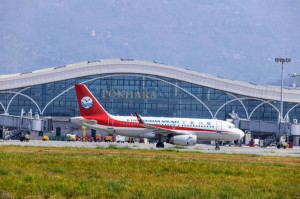Fri, Dec 19, 2025
Editorial
First things first
Steps to avoid the loss of strategic land in Nepal-Tibet border must be taken
bookmark
Published at : January 15, 2019
Updated at : January 15, 2019 08:55
When Chinese authorities first began constructing an embankment in Kimathanka, one of Nepal’s smallest and most remote settlements nestled in Sankhuwasabha, it was barely 150 metres long. Five years later—following a pattern of governmental oversight—it has amassed considerably. Local leaders say that the construction of the embankment, which is now close to completion, may result in the inundation of nearly 200 ropanis of land that is strategically important for Nepal. The effects are already visible: the Arun river has already begun changing its course from Kimathanka and local residents fear that their land could submerge ‘anytime’ during the rainy season.
Alarmingly, the people at the forefront of negotiations have been Kimathanka’s local government and people. When the Arun river first started cutting land on the Nepal side, the then Kimathanka Village Development Committee—now Bhotekhola Rural Municipality—had spent over Rs10 million to protect the land.Their concerns have also been continually dismissed by Chinese authorities. As their bargaining power is considerably affected by their fears of losing access to the markets across the border, on which they depend for almost all basic amenities, intervention from central and provincial governments is of vital importance.
Read:
Chinese construction along the Nepal-Tibet border puts strategic land at riskInstead, concerned authorities have seemingly been preoccupied with ‘the preparation of the structural designs of at least six offices’—including a customs office, a dry port, border outposts, and an immigration quarantine. While these are necessary structures, their purposes will be entirely defeated if an embankment on the Nepali side is not constructed before flooding occurs. As recommended by Rajendra Gautam, a lawmaker from the federal Parliament, the construction of a one-kilometre-long embankment should be the federal government’s first priority. If it fails to act quickly, flooding will occur before any border infrastructure can be built—defeating the entire purpose of the north-south corridor. In the geopolitical theatre, the importance of land cannot be overstated. The concerned authorities must be extremely cautious about their country’s land and territory. It goes without saying that the construction of an embankment by the Chinese will generate far-reaching security concerns for us. There is widespread belief that greater connectivity with China will help kick-start economic growth. And rightly so. But at the same time, we cannot afford to act passively in the name of greater connectivity. China’s Nepal policy is driven by its domestic concerns pertaining to domestic security concerns related to Tibetan stability. China’s regional concerns are guided by containing India’s influence. While regional connectivity is important, it is equally important for the government to take cautionary and preparatory steps in order to adopt a strategic stance.
There is an evident communication gap between high-level officials in the Chinese construction alongside Nepal-Tibet border. The concerned line ministry must take cognisance of this fact and raise the issue with its Chinese counterparts at the earliest. As neighbors, we should be seeking win win solutions to any problems, not a high-handed approach where a bigger country—in terms of its population and economy—seeks to undermine a relatively small country. And the onus is on us to make this possible.
Most Read from Editorial
Editor's Picks
E-PAPER | December 19, 2025
×




 11.12°C Kathmandu
11.12°C Kathmandu














